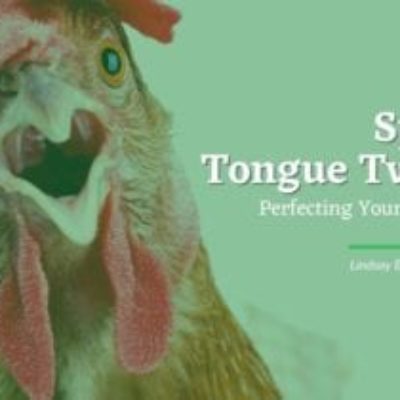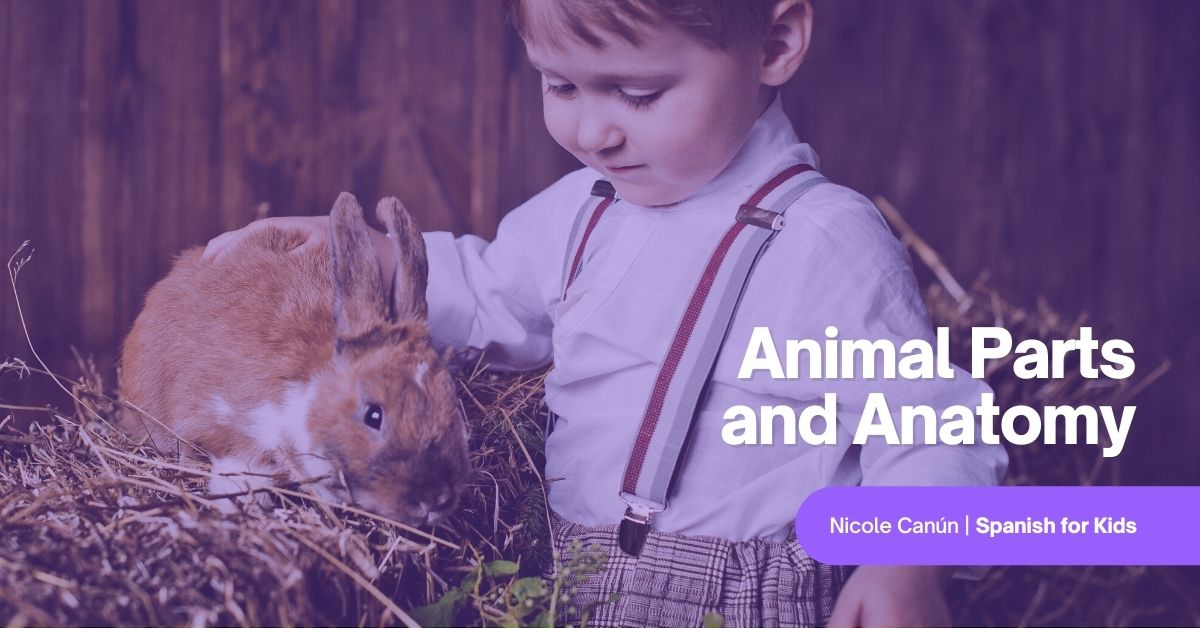
Animal Parts and Anatomy (Free Spanish Lessons for Kids)
Animals inspire empathy and fascination in kids, so I created this guide to animal parts in Spanish just for you!
The best way to interest your little one in learning a new language is to find an interesting topic that captures their attention.
In this lesson, you get downloadable and printable pictures of animals and their body parts in both Spanish and English. They’re categorized by animal and by function, including the animal digestive system, respiratory system, cardiovascular system, and skeletal system.
Find the fill in the blanks worksheet and after that, a matching game. They will strengthen your child skills on animal body parts.
¡Vamos!
Let’s go!
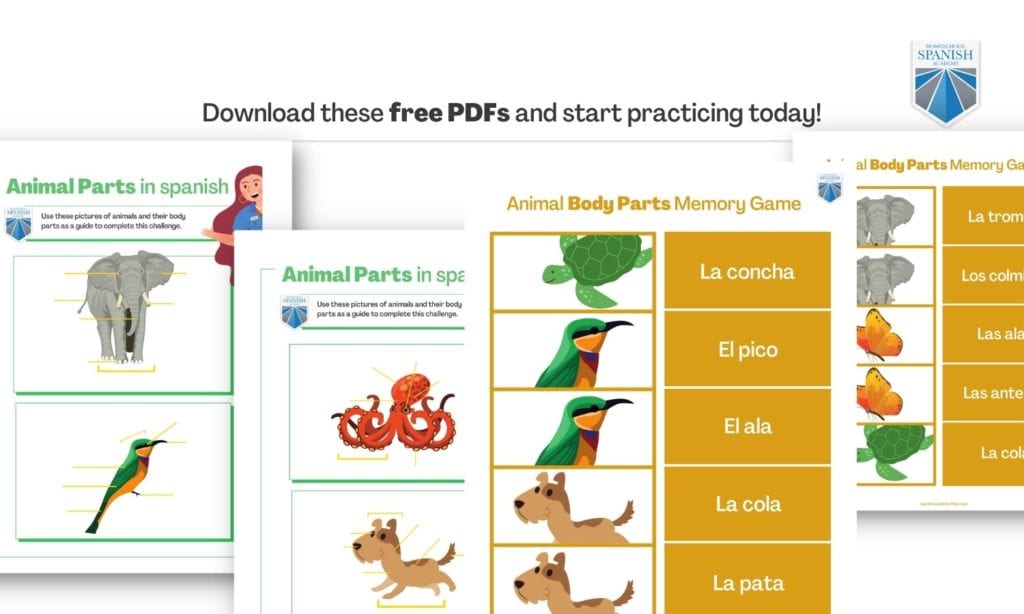
Download Our Free Animal Parts in Spanish Worksheets!
Just type in your name and email and we will immediately send two worksheets about animal parts in Spanish to your inbox!
Explore more FREE SPANISH LESSONS FOR KIDS! ➡️
Enjoy over 70 unique lessons + free activity packets to download.
Elephant – El Elefante
Elephants are Earth’s largest animales terrestres (land animals). They have the heaviest cerebro (brain) and are known for their amazing capacidad de memoria (memory capacity).
Their most unique physical characteristic is a trompa (trunk). With it they drink water and reach for food. Elephants have the world’s best sense of smell. But when it comes to animal parts, that’s not the only interesting one. Read ahead to find out more!
Did you know not all of the elephants’ dedos de los pies (toes) have uñas (nails)? The elefante africano (African elephant) has 4 nails on its front toes and only 3 on its back toes. In contrast, the elefante asiático (Asian elephant) has 5 and 4 respectively.
This list of animal parts includes skin since it is important to elephants. Its thickness and wrinkles enable them to endure heat and sunlight.
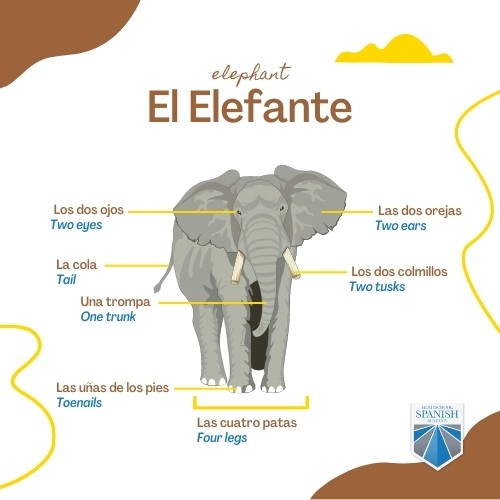
- Two eyes – Los dos ojos
- One trunk – Una trompa
- Two tusks – Los dos colmillos
- Four legs – Las cuatro patas
- Twenty toes – Los veinte dedos de los pies
- Two ears – Las dos orejas
- Tail – La cola
- Skin – La piel
- Head – La cabeza
- Mouth and lips – La boca y los labios
- Toenails – Las uñas de los pies
Elephant Respiratory System – Sistema respiratorio del elefante
These majestic animals can breathe both through their trunks and their mouths. See the rest of their animal respiratory organs on this chart:
- Lungs – Los pulmones
- Nares – Las fosas nasales
- Mouth – El hocico
- Trunk – La trompa
Elephant Digestive System – Sistema digestivo del elefante
Elephants are herbívoros (herbivores). They spend around 16 hours a day feeding, consuming approximately 300 to 600 pounds of food along with 25 to 50 gallons of water every day!
- Mouth – El hocico
- Molar teeth – Las muelas
- Tongue – La lengua
- Salivary glands – Las glándulas salivales
- Liver – El hígado
- Pancreas – El páncreas
- Pharynx – La faringe
- Oesophagus – El esófago
- Stomach – El estómago
- Small intestine – El intestino delgado
- Large intestine – El intestino grueso
Elephant Cardiovascular System – Sistema cardiovascular del elefante
Elephant hearts laten (beat) at a much slower rate (28 per minute) than humans (70 per minute). They also pumps sangre (blood) much harder.
- Heart – El corazón
- Veins – Las venas
- Arteries – Las arterias
- Ventricle – El ventrículo
Elephant Skeletal System – Sistema esquelético del elefante
Bones are the most important animal parts for an elephant. To support their large body, elephant bones are big and heavy. They have at least 326 and up to 351. The skeletal systems of all mammals are similar.
- Vertebrae – Las vértebras
- Spine – La espina dorsal
- Cranium / skull – El cráneo
- Mandible – La mandíbula
- Tusks – Los colmillos
- Molars – Las muelas
- Ribs – Las costillas
- Thorax – El tórax
- Hip – La cadera
- Tail vertebrae – Las vértebras de la cola
Bird – El Pájaro
When someone says pájaros (birds), we automatically think of animals that can volar (fly), but not all of them do. Some have evolved their wings for swimming like penguins and ratites. Find below how else we are different from them and learn their animal body parts.
Birds are not mamíferos (mammals). Although they are also warm-blooded vertebrates, they have toothless beaks, colored feathers and wings. They also share some organs and their functions with other creatures.
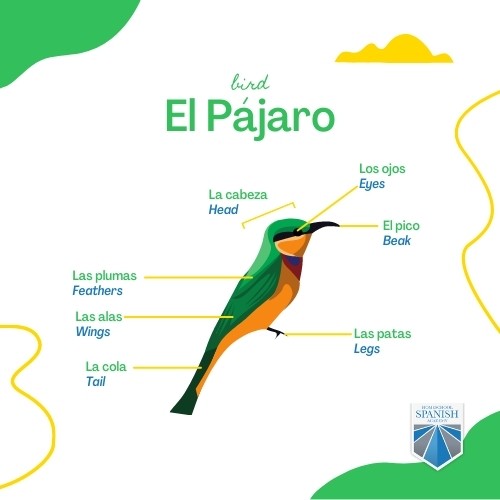
- Beak – El pico
- Legs – Las patas
- Feathers – Las plumas
- Tail – La cola
- Wings – Las alas
- Eyes – Los ojos
- Head – La cabeza
Bird Respiratory System – Sistema Respiratorio de las Aves
No living being has a more complex animal respiratory system than birds. While 25% of the air goes to the lungs, the rest is housed in cavities in the bones. Bird animal body parts and their functions can really surprise us.
- Trachea – La tráquea
- Cervical air sacs – Las bolsas de aire cervicales
- Humerus air sacs – Los sacos de aire del húmero
- Primary bronchi – Los bronquios primarios
- Thoracic air sacs – Las bolsas de aire torácicas
- Lungs – Los pulmones
- Abdominal air sacs – Los sacos de aire abdominales
Bird Digestive System – Sistema Digestivo de las Aves
Birds’ diets include plantas (plants), frutas (fruits), semillas (seeds) and even other little birds. Their animal digestive system is unique since they can store food and grind it with swallowed stones inside the gizzard. They are toothless, remember?
- Esophagus – El esófago
- Gizzard – La molleja
- Liver – El hígado
- Pancreas – El páncreas
- Caeca – El ciego
- Small and large intestine – Los intestinos delgado y grueso
Bird Cardiovascular System – Sistema cardiovascular de las aves
Birds have an efficient circulatory system to fulfill the constant demands of flying. When the blood is pumped around the body, it also carries and transports the following:
- Nutrientes (nutrients)
- Oxígeno (oxigen)
- Dióxido de carbono (carbon dioxide)
- Hormonas (hormones)
- Calor (heat)
- Desechos (waste products)
- Heart – El corazón
- Common carotid – La carótida común
- Systemic arch – El arco sistémico
- Coeliac – La celiaca
- First renal – La primera renal
- Iliac – La iliaca
Bird Skeletal System – Sistema esquelético de las aves
Birds’ skeletons are light so they can fly. Their bones are hollow and thin.
- Caudal vertebra – La vértebra caudal
- Ribs – Las costillas
- Sternum – El esternón
- Cranium – El cráneo
- Mandible – La mandíbula
- Phalanges – Las falanges
Explore more FREE SPANISH LESSONS FOR KIDS! ➡️
Enjoy over 70 unique lessons + free activity packets to download.
Octopus – El Pulpo
Octopus bodies are incredibly flexible. They alter their shape to fit into small hiding places.Their vision is excellent. Octopi are some of the most intelligent creatures on the planet!
If I say octopus, you immediately think of tentacles. They’re the most iconic animal body part of these extraordinary animals. Their whole bodies are rare and fascinating. This list is proof:
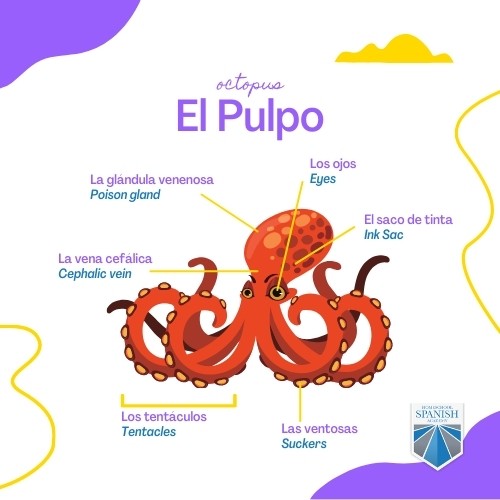
- Poison gland – La glándula venenosa
- Cephalic vein – La vena cefálica
- Ink sac – El saco de tinta
- Tentacles – Los tentáculos
- Eyes – Los ojos
- Suckers – Las ventosas
Octopus Respiratory System – Sistema respiratorio del pulpo
An octopus draws water through a cavity and expels it through a siphon. That’s how they propel their bodies. This means that their movement is related to their breathing. It’s as complex and fascinating as it sounds.
- Mantle – El manto
- Mantle cavity – La cavidad del manto
- Branchial canal – El canal branquial
- Gills – Las branquias
- Siphon – El sifón
Octopus Digestive System – Sistema digestivo del pulpo
Just like birds, octopuses store food only to later divide it into fluids and solids. Afterwards different membranas (membranes) absorb nutrients and waste is discarded.
- Buccal mass – La masa bucal
- Esophagus – El esófago
- Salivary glands – Las glándulas salivales
- Digestive gland – La glándula digestiva
- Digestive gland duct – El ducto de la glándula digestiva
- Stomach – El estómago
- Caecum – El ciego
- Intestine – El intestino
- Appendages – Los apéndices
Octopus Cardiovascular System – Sistema cardiovascular del pulpo
Did you know octopi have 3 hearts? One of them remains inactive while swimming. Of these 3 animal parts, one has the function of pumping blood throughout the body while the other two supply blood only for the two gills.
- Circulatory system – El sistema circulatorio
- Systemic heart – El corazón sistémico
- Branchial hearts – Los corazones branquiales
Dog – El Perro
The dog is the most variable species of the world in terms of size, colors, ears, tails, and hair. The smallest known dog was less than 4 inches long and weighed 4 ounces. The tallest one was 42 inches long and weighed 314 pounds!
For dogs, the most characteristic thing is how they use their cola (tail) to communicate emociones (emotions). It’s easy for humans to decipher what they mean with a few body movements including moviendo la cola (wagging their tails).

- Two ears – Las dos orejas
- Two eyes – Los dos ojos
- Two eyebrows – Las dos cejas
- Nose – La nariz
- Head – La cabeza
- Neck – El cuello
- Body – El cuerpo
- Chest – El pecho
- Back – La espalda
- Tail – La cola
- Fur – El pelo
- Four paws – Las cuatro patas
Dog Respiratory System – Sistema respiratorio del perro
Dogs breathe by bringing air through their noses and mouths through their tracheas and bronchi into the lungs. This system is shared by many mammals.
- Nasal cavity – La cavidad nasal
- Sinuses – Los senos nasales
- Lungs – Los pulmones
- Larynx – La laringe
- Trachea – La tráquea
- Diaphragm – El diafragma
Dog Digestive System – Sistema digestivo del perro
Dogs can’t chew from side to side due to their diet. While humans need to chew a lot to grind grains and vegetables, dogs only need to rip and swallow meat.
- Esophagus – El esófago
- Duodenum – El duodeno
- Teeth – Los dientes
- Tongue – La lengua
- Liver – El hígado
- Pancreas – El páncreas
- Intestines – Los intestinos
- Gallbladder – La vesícula biliar
- Stomach – El estómago
Dog Cardiovascular System – Sistema cardiovascular del perro
Dogs get heartburn. They produce more acid than humans do, so their diet is crucial. Their animal digestive system is 3 times faster and more efficient than humans’.
- Jugular – La yugular
- Carotid artery – La arteria carotida
- Aorta – La aorta
- Femoral artery – La arteria femoral
- Heart – El corazón
- Spleen – El bazo
Dog Skeletal System – Sistema esquelético del perro
Dogs have around 320 bones (humans only have 206). Some of the extra ones have to do with the extra teeth and tail vertebrae.
- Skull – El cráneo
- Orbit – La órbita
- Maxillary – El maxilar
- Scapula – La escápula
- Phalanges – Las falanges
- Rib cage – La caja torácica
- Caudal vertebrae – Las vértebras caudales
Turtle – La Tortuga
Giant tortoises have been objects of study for centuries for a reason. This fascinating creature can be up to 7 feet long and weigh more than 660 lbs. But you can also hold a little one on the palm of your hand.
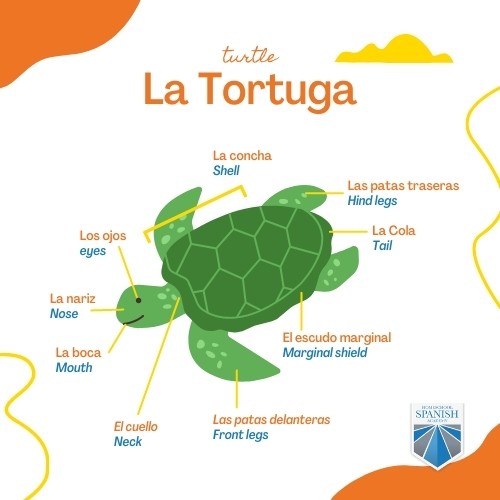
Turtles are known for their shell made of cartílago (cartilage) that works as a shield. They can retract their neck. Their heritage goes back to Jurassic times!
- Shell – La concha
- Tail – La cola
- Front legs – Las patas delanteras
- Hind legs – Las patas traseras
- Claws – Las garras
- Marginal shield – El escudo marginal
- Eyes – Los ojos
- Nose – La nariz
- Mouth – La boca
- Mandible – La mandíbula
- Neck – El cuello
- Head – La cabeza
Turtle Respiratory System – Sistema respiratorio de la tortuga
Cloacal respiration is a unique system that turtles have where they breathe… through their butts. They get oxygen by moving water against their bodies, which are covered with blood vessels. And what part of the turtle’s bodies have the most blood vessels? You guessed it: their butts.
- Mouth – La boca
- Trachea – La tráquea
- Larynx – La laringe
- Lungs – Los pulmones
- Bronchus – Los bronquios
- Glottis – La glotis
Turtle Digestive System – Sistema digestivo de la tortuga
Land turtles eat gusanos (worms), caracoles (snails), cienpies (caterpillars), escarabajos (beetles), fruta (fruit), hongos (mushrooms), flores (flowers), and carroña (carrion). Talk about a balanced diet!
- Colon – El colon
- Kidney – El riñon
- Stomach – El estómago
- Bladder – La vejiga
- Small intestine – El intestino delgado
- Esophagus – El esófago
- Liver – El hígado
- Large intestine – El intestino grueso
- Spleen – El bazo
- Gallbladder – La vesícula biliar
Turtle Cardiovascular System – Sistema cardiovascular de la tortuga
- Pulmonary vein – La vena pulmonar
- Left atrium – La aurícula izquierda
- Right atrium – La aurícula derecha
- Systemic capillaries – Los capilares sistémicos
- Heart chambers – Las cámaras del corazón
Turtle Skeletal System – Sistema esquelético de la tortuga
Turtles have no muscles between their ribs, which makes it easier for them to have a hard exoskeleton where some of their bones are fused together.
- Mandible – La mandíbula
- Pelvic girdle – La cintura pélvica
- Back bone – La columna vertebral
- Ulna – El cúbito
- Radius – El radio
Butterfly – La Mariposa
Butterflies are the poster child of transformation. Their animal body parts change when they morph from a caterpillar into a completely different animal?
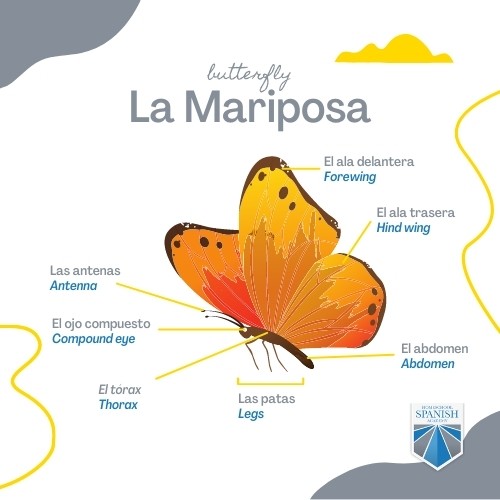
Most butterflies have colorful wings. Other parts of a butterfly include
- Antenna – Las antenas
- Thorax – El tórax
- Compound eye – El ojo compuesto
- Head – La cabeza
- Legs – Las patas
- Abdomen – El abdomen
- Forewing – El ala delantera
- Hind wing – El ala trasera
- Wing veins – Las venas de las alas
Butterfly Respiratory System – Sistema respiratorio de la mariposa
Butterflies don’t have lungs, they breathe through little side holes called spiracles that carry oxygen throughout their bodies.
Butterfly Digestive System – Sistema digestivo de la mariposa
These beautiful insects feed almost exclusively on fluids. They drink nectar with their tongue in the form of a straw, which coils and uncoils.
- Proboscis – La probóscide
- Digestive tract – El tracto digestivo
- Malpighian tubules – Túbulos de Malpigui
Butterfly Cardiovascular System – Sistema cardiovascular de la mariposa
Butterflies don’t need blood movement to obtain oxygen, so their circulatory system is simple. Blood goes from heart to abdomen, head, and back to the heart.
- Heart – El corazón
- Dorsal vessel – El vaso dorsal
- Conducting vessel – El vaso conductor
Practice these Animal Parts!
Practice this class so the vocabulary sticks with you! Meet our kid-friendly, certified teachers who provide 1-on-1, fun Spanish instruction in real-time. Homeschool Spanish Academy will help you tailor the perfect Spanish package including everything your child needs. Join our 24,000+ monthly students and let our 10 years of experience talk on our behalf. Sign your child up for a free trial class today!

Join one of the 40,000 classes that we teach each month and you can experience results like these

“This is the best way for your kid to learn Spanish. It’s one-on-one, taught by native Spanish speakers, and uses a curriculum.”
– Sharon K, Parent of 3

“My Son, Heath, is taking the classes. He’s been with Luisa the entire time and we absolutely love her. She is always patient and is a great teacher. Heath’s dad speaks Spanish so they get to have little conversations.”
– William R, Parent of 3

“It’s a great way to learn Spanish, from native Spanish speakers in a 1-on-1 environment. It’s been fairly easy to schedule classes around my daughter’s other classes. The best value for us has been ordering multiple classes at a time. All the instructors have been great!”
– Cindy D, Parent of 3
Want more free Spanish lessons, fun content, and easy learning strategies for kids? Check these out!
- Keep Your Spanish Skills Sharp Over Summer Vacation
- Discover the Joy of Learning Spanish with Summer Fun Activities
- 7 Powerful Reasons Why Bilingualism in Children MattersPowerful Reasons Why Bilingualism in Children Matters
- Fall En Español: Exploring Autumn Activities for Kids
- Fun and Language: Spanish Playdates for Kids
- Milestone Moments: Tracking Kids’ Spanish Progress
- Building Blocks: Kid-Friendly Spanish Grammar
- Top 5 Spanish Grammar Games to Improve Your Language Skills
- What Is An Umbrella School? - June 20, 2024
- Car Parts Spanish Vocabulary List: Learn Using Pictures - February 1, 2024
- Discovering The Mayan Languages - January 4, 2024




